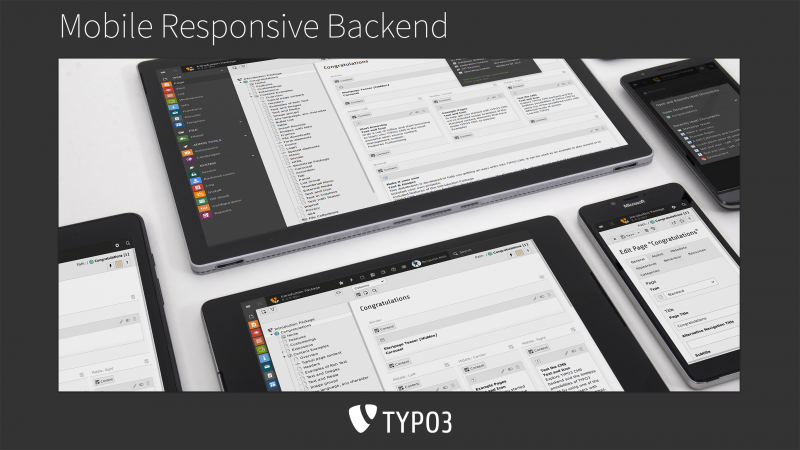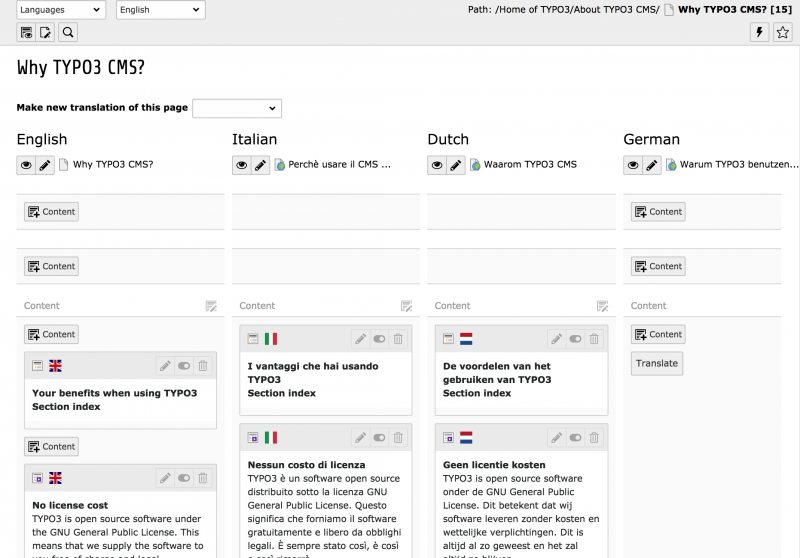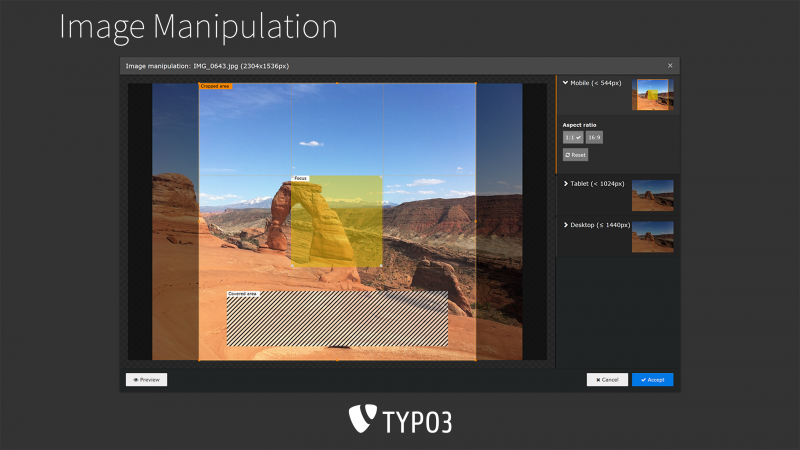
TYPO3
Characteristics
Programming language:
Initial release:
Open Source as of:
License:
Current major release:
Registered users:
Core contributors:
Total downloads:
Available languages:
TYPO3 has pragmatic, professional roots in the world of digital agencies. Its design and development direction has always been to enable digital agencies to serve their customers best. The community likes to call TYPO3 CMS “The Enterprise Content Management System” and it retains strong adoption in universities, government, and enterprises in central Europe among its 500,000+ reported installations. It is supported by a large agency- and service provider-base, especially in the “DACH” German-speaking region. The community and the TYPO3 Association worked hand-in-hand to found TYPO3 GmbH, the commercial arm of the project in 2016. It provides services aimed at increasing the commercial sustainability of the whole TYPO3 ecosystem. These include project reviews, SLA-based- and extended-support for TYPO3 CMS, and a partner program. In addition TYPO3 GmbH manages parts of the core development, as well as acting as the TYPO3 CMS official software vendor when needed.

For site owners and administrators, TYPO3 has a track record of delivering good ROI, powering stable long-term installations – some online for 10+ years (with regular updates and maintenance, of course) – that are still flexible enough to support innovation. For older installations, there are smooth migration paths to version 8.x from versions 4.5, 6.x, and 7.x.
TYPO3 CMS offers excellent multi-language and localisation support with nice-to-have features like side-by-side content translation for editors. The administrative interface is itself responsive and has built-in responsive preview functionality, supporting working from any device and screen size.
For developers, version 8.x is built for up-to-date workflows and deployments, with full cloud support, components from the Symfony framework, Composer-based package management, compatibility with PHP 7 and a number of the PHP-FIG PSR standards, up to and including PSR 7. Doctrine became the database abstraction layer in v8, making TYPO3 CMS compatible with MS-SQL, Postgres, MySQL/MariaDB and other popular database technologies. When it comes to building and customising sites and applications with TYPO3 CMS, developers can call upon more than 6,000 existing extensions, a strong community of peers, and the flexibility to build almost any web application you can imagine.
Innovation, Predictability - TYPO3 CMS major versions are delivered on a regular 18-month release cycle and include a Long-Term-Support release concept. TYPO3 8 was released in March 2016 to be fully supported until TYPO3 9 LTS is released in 2018, and will be supported with security and critical fixes until March 2020. Once community support expires for a major version, TYPO3 GmbH offers support for the most recent deprecated major release through its (commercial) Extended Long-Term Support program.
Security - TYPO3’s Security Team follows security issue reporting and resolution best practices regarding TYPO3 CMS and 3rd party extensions. Subscribe to security bulletins to be informed about vulnerabilities in the core and 3rd party extensions.

Highlights
Multi-Site
The TYPO3 page tree and inheritance concept, data model, and granular user access management are perfectly adapted for running massive, performant multi-site installations. A single TYPO3 CMS base installation can support large numbers of individual sites that share, reuse, or syndicate content and configuration. The same installation can offer specific user types access to make changes specific, individual sites or characteristics where needed – well suited to large corporate use cases where product names or legal compliance issues vary from country to country. That means you can have both central control over all content and brand strategy elements and allow local editorial access as required.
Individual pages are cached when generated, meaning performance is not dependent on the number of sites within a multi-site installation, but rather the overall size of the database which is a easily solved and scaled using well understood database technology options.

Multilingual
TYPO3 CMS offers good usability for creating and maintaining multilingual website. Combined with the multi-site capabilities, this makes for a powerful combination; for example, there is TYPO3 CMS installation online powering 66 local sites in a total of 88 languages while remaining performant and maintainable.
The translation interface is intuitive to use and offers integration with a variety of translation services. One nice feature is that content translations can have nested dependencies on parent content. Once they are marked as “completed” and their parent content is changed, the CMS can flag the translations as in need of revision and inform the appropriate users of the open task.
Any Data, Any Source
TYPO3 CMS comes with a file system abstraction layer out-of-the-box. This allows you to use and combine any number of file storage systems and locations to suit the needs and technical knowledge of your teams. The CMS takes care of indexing and relationships to content while remaining completely transparent to editors. Existing file service integrations include Akamai, Alfresco, SixOMC, Cumulus, QBank DAM, Dropbox, Magento, and Amazon S3. You can use the local disk, secure out-of-docroot storage on your webserver only accessible to authorised CMS users, and of course create new integrations for the services of your choice.
Mobile: Apps, Responsive Sites
TYPO3 CMS can act as the content management, business logic, and content provider for native mobile applications (like iOS, Android) and front-end frameworks (Ember, React, Angular, etc.). It also takes advantage of HTML5 to provide fully responsive websites for site visitors and admins.
Users can create users within their team
Users can be given permission to create other users with the same or fewer access permissions as themselves. This allows, for example, a university professor to create teams of assistants on a university website without having to go through a site administrator.
Content History
TYPO3 CMS keeps an unlimited history of content publication and revision; what was changed, when, and by whom. All changes can be displayed as a visual “diff” (showing what was removed and what was added), and can be selectively undone, even un-deleted.
Static (HTML) Export
TYPO3 CMS can export the current state of your site as fast, secure, static HTML. If you’re building sites that do not rely on user interaction, but you want CMS functionality, TYPO3 CMS will let you build and export static sites ready to be hosted on Google Pages or GitHub.
Professional development processes
Professional development processes for TYPO3 CMS core, including measures for ongoing quality assurance, such as unit testing, versioning, code reviews, and an extensive project management team are an integral part of the platform.

Challenges
The TYPO3 community lost momentum for a few years due to a split that led to the jump from TYPO3 CMS version 4.x to 6.x. The community took the chance to professionalise its processes and has since reemerged, fully recovered and energised from the experience.
TYPO3 CMS 8 is a product of the PHP-interoperability era, adopting up-to-date coding standards via the PHP-FIG PSR standards, Symfony, Composer and other external components in its core. PHP developers will find many familiar tools that will deliver great results. Despite this, TYPO3 still relies on two open source technologies unfamiliar to most outside of TYPO3: the fluid templating engine and the Typoscript integration syntax used to configure parts of TYPO3.
TYPO3 has its strongest adoption in the German-speaking “DACH” region and central Europe. The community may still feel quite “German” to newcomers, but things are changing. The community is expanding internationally with the full support of the TYPO3 Association, TYPO3 GmbH, and individual community members; with official events, documentation, and communication all in English.

Community, Events, Certification
More than 75,000 registered TYPO3 developers, 1,200+ certified TYPO3 integrators, and more than 1,000 TYPO3 Association members are all committed to contributing great open source software to the world. You can find community members and conversations on the TYPO3 Slack channel at typo3.slack.com.
The reorganisation and professionalisation of the TYPO3 CMS development process since version 6.x has revitalised the TYPO3 community. Alongside well-attended, well-run events, the community has organised itself into a series of specialist groups responsible for a variety of areas of the project. Depending on your skills and interests, you may find a warm welcome contributing to core development, user experience, design, marketing, and more.
TYPO3 community events give existing and potential users – agencies, institutions, developers – the opportunity to get to know TYPO3 CMS, its capabilities and the latest developments in the TYPO3 family. Through the year, the event calendar includes national and international conferences, meetups, and get togethers ranging from Agency Meetup Days, to the Developer Days, university-focused events, workshops, the “certi-fun-cation” day … and even TYPO3 community skiing and sailing trips.
Certification - To assure the highest service quality and application implementations, the TYPO3 community manages a series of professional certifications, including TYPO3 Certified Integrator, Certified Developer, and Certified Editor.
